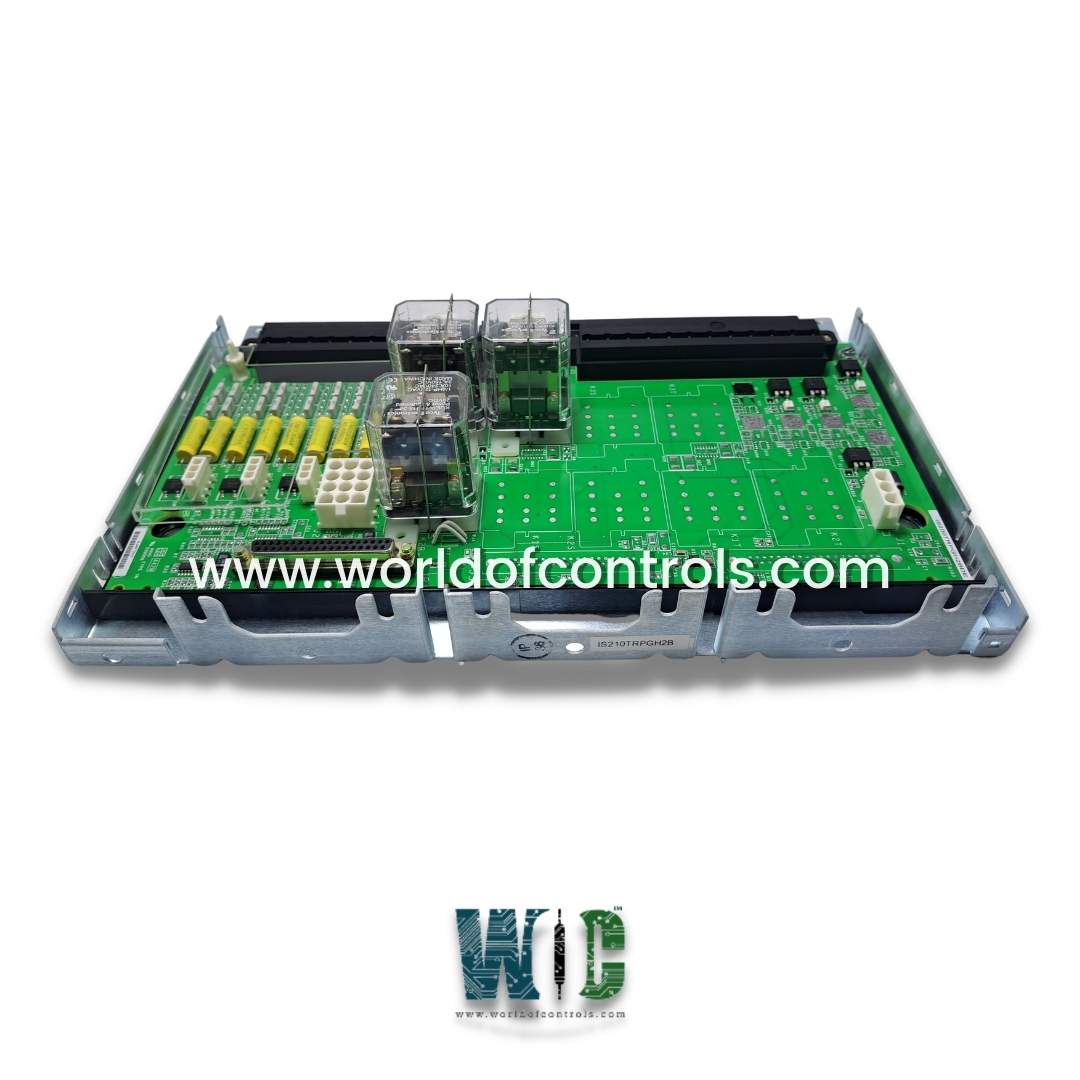SPECIFICATIONS
Part No.: IS210TRPGH2B
Manufacturer: General Electric
Country of Manufacture: United States of America (USA)
Flame detectors: 8
Product Type: Trip Output Terminal Board
Availability: In Stock
Series: Mark VI
Functional Description
IS210TRPGH2B is a Trip Output Terminal Board developed by GE. It is a part of Mark VI control system. The TRPG (Trip Relay Primary Group) terminal board operates under the control of the I/O (Input/Output) controller. Its functionality is tailored to interface with the Electrical Trip Devices (ETD) through nine magnetic relays organized into three voting circuits. These relays are responsible for interfacing with trip solenoids, forming the primary and emergency sides of the interface to the ETDs in collaboration with the TREG (Trip Relay Emergency Group).
Features
- Magnetic Relays and Voting Circuits: The TRPG board houses nine magnetic relays distributed across three voting circuits. These relays play a pivotal role in controlling trip solenoids, facilitating the activation of protection mechanisms within the system.
- Integration with TREG: Working in tandem with the TREG, the TRPG board forms the primary and emergency sides of the interface to the ETDs. This collaboration ensures comprehensive trip functionality and enhances system reliability.
- Flame Detection Inputs: In addition to its trip control functions, the TRPG board accommodates inputs from eight Geiger Mueller flame detectors, specifically designed for gas turbine applications. These detectors enhance safety measures by detecting potential flame-related hazards.
- Primary Trip Function: The I/O board takes charge of the primary trip function by controlling the relays on the TRPG board. These relays are instrumental in triggering the main protection solenoids, thereby safeguarding the system against critical faults or abnormalities.
- Hardware-Based Voting Logic: In Triple Modular Redundancy (TMR) applications, the three inputs are subjected to hardware-based voting logic using a relay ladder logic two-out-of-three voting circuit. This redundancy scheme enhances system reliability by ensuring fault tolerance and fault detection capabilities.
- Relay Monitoring: The I/O board continuously monitors the current flow in its relay driver control line to determine the energize or de-energize vote/status of the relay coil contact status. Additionally, supply voltages are monitored for diagnostic purposes to ensure system integrity and performance.
- Diagnostics Monitoring: A critical aspect of the TRPG board's functionality is diagnostics monitoring, which involves monitoring the status of normally closed contacts from each relay. This monitoring mechanism is crucial for verifying the proper operation of the relays and detecting any potential malfunctions or abnormalities.
Voltage features
- Standard Voltage: The standard voltage for the system is 125 V dc, allowing for a maximum draw of up to 1 A. This voltage level is commonly used to power various components within the system, providing stable and reliable electrical energy for their operation.
- Alternate Voltage: An alternate voltage option is available at 24 V dc, also capable of supporting a maximum draw of up to 1 A. This voltage configuration, accessible through terminals H1B, H2B, and H3B, offers flexibility in power supply options, catering to specific requirements or compatibility considerations.
Solenoid Response Time
- The solenoid response time is characterized by the L/R time constant, which is measured at 0.1 seconds.
- This parameter denotes the time required for the solenoids to achieve a steady-state response after an input signal is applied. A short response time ensures rapid and efficient operation of the solenoids, contributing to the overall performance and responsiveness of the system.
Current Suppression
- The system incorporates Metal Oxide Varistors (MOV) on the TREG (Trip Relay Emergency Group) to suppress excess current and protect against voltage spikes or transient surges.
- MOVs are effective in diverting high-energy transient events away from sensitive components, ensuring reliable operation and safeguarding against damage or malfunction.
Current Economizer
- Terminals are provided on the TREG for the optional installation of a 10 ohm, 70 W economizing resistor. This resistor serves as a current economizer, regulating the flow of current within the system to optimize energy efficiency and minimize power consumption. By introducing resistance into the circuit, the economizer helps to stabilize current levels and reduce overall power requirements.
Control Relay Coil Voltage Supply
- Relays within the system are supplied with a voltage of 28 V dc, sourced from terminals JR1, JS1, and JT1.
- This voltage supply ensures proper operation and activation of the relays, enabling them to perform their designated functions effectively. Consistent and reliable voltage supply is essential for maintaining the integrity and performance of the relay-based control system.
The WOC team is always available to help you with your Mark VI requirements. For more information, please contact WOC.
Frequently Asked Questions
What is IS210TRPGH2B?
It is a Trip Output Terminal Board developed by GE under the Mark VI series.
What diagnostics does the I/O board run on the TRPG (Trip Relay Primary Group)?
The I/O board performs diagnostics on various aspects of the TRPG, including feedback from the trip solenoid relay driver and contact, solenoid power bus, and the flame detector excitation voltage. These diagnostics ensure the proper functioning of critical components within the system.
What triggers a diagnostic alarm on the TRPG?
A diagnostic alarm is triggered if any of the monitored signals exceed predefined limits or fall below acceptable thresholds. This could indicate potential faults or abnormalities in the system, prompting timely intervention or maintenance.
How does the I/O board handle hardware compatibility issues with connectors JR1, JS1, and JT1?
Connectors JR1, JS1, and JT1 on the terminal board are equipped with their own ID devices, containing information such as the terminal board's serial number, board type, revision number, and plug location. The I/O board interrogates these ID devices, and if a mismatch is detected, indicating a hardware incompatibility, a fault is generated to alert the operator.
